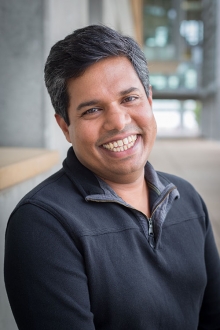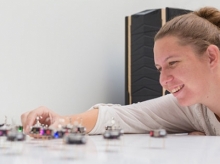 All of life is motion — whether it is molecules shuttling around within our cells or flocks of birds in the sky.
All of life is motion — whether it is molecules shuttling around within our cells or flocks of birds in the sky.
Physics Professor Ajay Gopinathan, with the School of Natural Sciences, and the researchers in his lab are investigating the general principles governing such biological transport — understanding how reliable transportation occurs in biological systems across different levels of organization and scales in complex settings.
Such settings include the crowded interior of cells, where an array of dynamic protein filament tracks direct intracellular traffic. Work in Gopinathan’s lab, featured on the cover of a recent Biophysical Journal issue , shows the filament network’s structure is as important in determining how cellular transport goes as a road network is to vehicular traffic. The lab, led by then-graduate student David Ando — now a postdoctoral researcher at Lawrence Berkeley National Laboratory — and in collaboration with Professor K.C. Huang's group at Stanford University, also found that cells can tune this network to optimize transport.
 Student Katherine Copenhagen shows the kilobots she works with in Professor Gopinathan's lab. Studying flocking behavior could enable her and other researchers to program robots to behave like animals that flock or swarm.
Student Katherine Copenhagen shows the kilobots she works with in Professor Gopinathan's lab. Studying flocking behavior could enable her and other researchers to program robots to behave like animals that flock or swarm.
Another aspect of transport is the emergence of collective motion.

